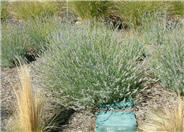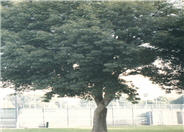
Common name:Hybrid Tea Rose cultivar
Botanical name:Rosa Hybrid Tea selection
Hybrid tea roses are the traditional classic roses; buds are used for boutonnieres. These roses have long stems with a single rose at the end, which may or may not be fragrant. Blooms typically start in spring until fall. Many colors now available. Roses prefer full to part sun with well draining, rich soil. It needs fertilizer after each bloom period. It prefers medium watering and more in hot summer areas. Mulch well. Prune in winter. It usually grows 2'-6' tall.

Common name:Rosemary
Botanical name:Rosmarinus officinalis
Rosemary is hardy in full sun areas where winter temperatures do not drop below 10 degrees F. Rosemary is evergreen and makes a great aromatic hedge, 4'-6' tall and 2' wide. Foliage is used in cooking. Blue flowers appear in summer. This plant is drought tolerant once it's established. Bees love Rosemary!

Common name:Monarch Blanket Flower
Botanical name:Gaillardia X grandiflora 'Monarch'
Gaillardia gra. 'Monarch' is a perennial. Grows to 2'-4' high, 1.5' wide, with roughish grey-green foliage and single or double mixed red and yellow bicolor blooms 3"-4" across. Exceptionally long bloom. Keep dead-heading and they'll bloom til frost.

Common name:Grosso Hedge Lavender
Botanical name:Lavandula X intermedia 'Grosso'
Long-stemmed Lavender has beautiful violet-colored plumes in the summer. Very drought tolerant and it is a great plant to create that Mediterranean effect.

Common name:Arizona or Velvet Ash
Botanical name:Fraxinus velutina
This rounded tree will grow 30'-50' tall and has glossy, bright green leaves that turn yellow and gold in the fall. The leaves are soft and velvety, and the trunk is slender and gray. This tree is hardy to about -10 degrees F. This deciduous tree is heat tolerant and needs a moderate amount of water.

Common name:Deodar Cedar
Botanical name:Cedrus deodara
This fast-growing, coniferous evergreen is capable of reaching a size of 80' high by 40' wide. Its needles are a light, silvery green color, 2" long. Flowers are inconspicuous. Barrel shaped cones appear in fall and winter. Branches are pendulous and spreadings. Plant in area that has ample room for growth.
| Designer: Susan Stiltz | Another View of Beds |
Photographer: GardenSoft |
Soils and Compost:
Incorporate compost 6" into your soil to retain water, reduce compaction, feed earthworms, and provide valuable nutrients to your plants.
Water Saving Tip:
Replace turf with groundcovers, trees, and shrubs. If you have areas where no one uses the grass, patches that do not grow well, or a turf area too small to water without runoff, consider replacing the turf with water-efficient landscaping.
Integrated Pest Management:
Develop healthy soil for plants that are vigorous and naturally pest-resistant.

